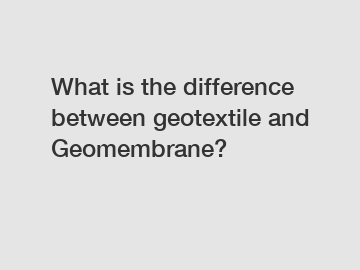What is the difference between geotextile and Geomembrane?
Link to EcoGeoX
As we delve into the world of geosynthetics, two terms that often come up are geotextile and geomembrane. At first glance, they may seem interchangeable, but in reality, each serves a unique purpose in various applications. In this blog, we will explore and spotlight the differences between geotextile and geomembrane, shedding light on their individual characteristics, functions, and benefits within the field of engineering and construction.
Understanding Geotextile:

Geotextile, often referred to as the versatile "engineered fabric," is constructed from synthetic materials such as polypropylene or polyester. Typically non-woven, it is designed to perform numerous functions when placed within soil or rock structures.
Geotextiles work as a separator, allowing water to pass through while preventing the mixing of different soil layers. They also act as a filter by retaining fine particles within the soil, ensuring efficient drainage. Additionally, geotextiles provide reinforcement, increasing the stability and load-bearing capacity of construction projects.
Applications that commonly harness the power of geotextiles include road construction, erosion control, landfills, agriculture, and drainage systems. Their permeability, durability, and adaptability make them indispensable in projects that require enhanced soil performance, protection against erosive forces, and water management.
Understanding Geomembrane:
Whereas geotextiles are primarily concerned with soil characteristics, geomembranes offer a more efficient barrier against fluids and gases. These synthetic membranes are usually manufactured from high-density polyethylene (HDPE), low-density polyethylene (LDPE), or polyvinyl chloride (PVC).
Geomembranes excel in containing and isolating liquids and gases, ensuring environmental protection and integrity. Common applications of geomembranes include landfill liners, hazardous waste containment, ponds, reservoirs, and water storage facilities. Due to their impermeability, they effectively prevent the seepage and migration of harmful substances into the environment.
Differentiating Factors:
Fabrication: Geotextiles are non-woven fabrics, created by intertwining fibrous materials or threads together. In contrast, geomembranes are manufactured as solid sheets using high-quality polymers, offering greater integrity.
Functions: Geotextiles primarily act as separators, filters, and reinforcements within soil structures. On the other hand, geomembranes function as reliable barriers against liquids and gases, protecting the environment and infrastructure.
Applications: Geotextiles find extensive use in road construction, erosion control, agriculture, and drainage systems. Geomembranes, with their impermeability, are ideal for containment systems like landfills, wastewater treatment plants, and hazardous waste storage.
Physical Properties: Geotextiles are permeable and allow water to pass through, but not fine particles. In contrast, geomembranes are completely impermeable and function to contain liquids or gases.
Integrating Both: Synergy and Versatility.
While geotextiles and geomembranes have distinct primary functions, they can often work together to optimize performance and offer added benefits. For example, when used in combination, geotextiles can help protect geomembranes from punctures or abrasions during installation. This not only enhances the integrity of the containment system but also ensures longevity and cost-effectiveness.
The collaboration between geotextiles and geomembranes demonstrates the versatility of geosynthetics in engineered applications. By combining their strengths, engineers can design comprehensive and efficient solutions to meet diverse project requirements.
Conclusion:
In summary, geotextiles and geomembranes may share certain characteristics as geosynthetics, but their areas of expertise lie in distinct fields. Geotextiles excel as soil reinforcement, drainage facilitators, and erosion controllers, while geomembranes play a vital role as fluid and gas containment systems. Understanding their unique functions and applications is essential for engineers, construction professionals, and environmental consultants, enabling them to make informed decisions and select the most suitable geosynthetic materials for their projects.
As geotechnical engineering continues to evolve, the distinction between geotextiles and geomembranes remains paramount. By harnessing the expertise of these materials, we can construct robust and sustainable solutions to address soil stability, environmental protection, and fluid containment challenges, ensuring a safer and more resilient world.
Please visit our website for more information on this topic.
Want more information on Cement Blanket Supplier? Feel free to contact us.



